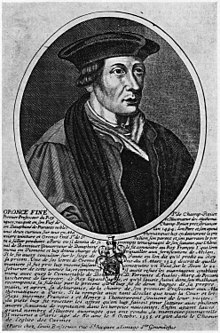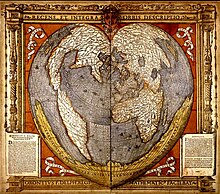Oronce Fine
Oronce Fine , also Oronce Finé, Latinized Orontius Finnaeus or Finaeus, (born December 20, 1494 in Briançon , † August 8, 1555 in Paris ) was a French mathematician and cartographer.
Life
Fine was the son of a doctor and studied after the death of his father in Paris medicine at the Collège de Navarre with the bachelor's degree in 1522. In Paris he was sponsored by Antoine Sylvestre, professor at the Collège de Montaigu. While still a student in 1518 and 1524 he was imprisoned for some time, possibly for practicing astrology . In 1531 he became a mathematics professor at the Collège Royale , founded by the king the year before , where he taught until his death. There are portraits of him based on a lost painting by Jean Clouet (1530).
During his medical studies (from around 1515) he published mathematical and astronomical works for a Parisian printer, for example by Sacrobosco (Tractatus de Sphaera) and Georg Peuerbach (Theoricae novae planetarum). He also published many of his own works in mathematics, astronomy (for example De mundi sphaera 1542, a popular scientific work on astronomy), on instrument science (for example his first book in 1526 on the equatorium and on the quadrant , the astrolabe and the gnomon ) and Optics. In 1532 his work Protomathesis appeared in several volumes, which treated arithmetic, geometry and in the third and fourth part astronomy and astronomical instruments. An ivory sundial made by him from 1524 is still preserved today. His name is engraved on it and it is the only instrument that can be directly attributed to him. He was involved in the construction of the astronomical clock in the Sainte-Geneviève library (it uses a method from a treatise by Fine on astrology). Overall, Emmanuel Poulle characterizes the work of Fine as encyclopedic, elementary and non-original , as a popularization of the scientific subjects about which he himself had heard lectures.
He became known for his maps, in particular a double heart-shaped map projection that he invented (already in his first world map from around 1519), which was also adopted by Peter Apian and Gerhard Mercator . One of his world maps came from around 1519, the other appeared in 1531 (Nova Universi Orbis Descriptio). His later world map from 1531 is based on that of Johannes Schöner (whose globe dates from 1523). In his world map he used information from Claudius Ptolemy as well as more recent discoveries (such as information from Marco Polo or from explorers like Ferdinand Magellan ). On his world map he draws Asia and North America as a land mass (which he calls Asia, so that Marco Polo's designations for China appear in the Caribbean), America he designates South America and a Terra Australis drawn on the map may be based on information from Magellan returned via Tierra del Fuego. The fact that the Terra Australis had roughly the shape of Antarctica on his map occupied later authors such as Charles Hapgood and it has been suggested that he used sightings of the north coast of Australia by Portuguese sailors and postulated the existence of a larger land mass from it (the idea of a southern continent common since Ptolemy).
In 1525 he published a map of France, one of the first of its kind, and he later published maps of the Holy Land (Palestine) and the Travels of Paul .
Pedro Nunes published a paper in 1546 in which he refuted the alleged solution of the three classical geometrical problems of angle trisection, cube doubling and circle quadrature by Fine. His attempts at circular quadrature were also criticized by other contemporaries such as Johannes Buteo . Fine gave various approximate values for the circle number Pi, most recently in De rebus mathematicus in 1556 . He also dealt with fortifications (for example those of Milan on behalf of King Francis I - he came from prison for this in 1524) and gave a method of determining the length from the observation of lunar eclipses in two different places. He edited the Elements of Euclid (1536, 1544, 1551).
The lunar crater Orontius is named after him. The same applies to Finaeus Cove , a bay on the Graham Coast of Graham Land in Antarctica.
literature
- Emmanuel Poulle Oronce Fine in Dictionary of Scientific Biography
- Alexander Marr (editor) The Worlds of Oronce Fine: Mathematics, Instruments and Print in Renaissance France , Donington, Lincolnshire, Shaun Tyas, 2009, ISBN 978-1900289-96-2
- L. Gallois De Orontio Finaeo gallico geographo , Paris, 1890 (dissertation, treats Fine only as a cartographer)
- Richard P. Ross Studies on Oronce Fine (1494-1555) , Dissertation, Columbia University, 1971 (discusses mathematics, not astronomy)
- Richard P. Ross Oronce Fine's De minibus libri II: The First Printed Trigonometric Treatise of the French Renaissance , Isis, Volume 66, 1975, pp. 378-386
- D. Hillard, Emmanuel Poulle Oronce Fine et l'horloge planétaire de la Bibliothèque Sainte-Geneviève , Bibliothèque d'Humanisme et Renaissance , Volume 33, 1971, 311–351 (with the addition of the fine list of publications by Richard Ross, Bibl. d'humanisme et renaissance, Volume 36, 1974, pp. 83-85)
- Science et astrology au XVIe Siècle. Oronce Fine et son horloge planétaire , exhibition catalog Bibliothèque Sainte-Geneviève, Paris, 1971
Web links
- Literature by and about Oronce Fine in the catalog of the German National Library
- John J. O'Connor, Edmund F. Robertson : Oronce Fine. In: MacTutor History of Mathematics archive .
- Oronce Fine in the Galileo Project
- Article by Emmanuel Poulle in the Dictionary of Scientific Biography
Individual evidence
- ↑ also according to its place of origin from the Dauphiné Orontius Finaeus Delphinatus
- ↑ His grandfather was also a doctor and in 1522 Fine published a paper by him about the plague
- ↑ In the Galileo Project (see web links) a horoscope against a high noble or the opposition to the Bologna Concordat 1516 are given as possible reasons for the imprisonment in 1518
- ^ According to the article by Poulle in the Dictionary of Scientific Biography (1970s) it is in a private collection in Milan
- ^ Poulle, Dictionary of Scientific Biography. According to Poulle, the clock itself does not come from Fine, but from the 15th century, but Fine replaced one of the display panels around 1553.
- ↑ Fine's scientific work may be briefly characterized as encyclopedic, elementary, and unoriginal . Dictionary of Scientific Biography
- ^ Hapgood Maps of the ancient sea kings , 1965
- ↑ The king also consulted him during the siege of Pavia
| personal data | |
|---|---|
| SURNAME | Fine, Oronce |
| BRIEF DESCRIPTION | French mathematician |
| DATE OF BIRTH | December 20, 1494 |
| PLACE OF BIRTH | Briançon |
| DATE OF DEATH | August 8, 1555 |
| Place of death | Paris |





